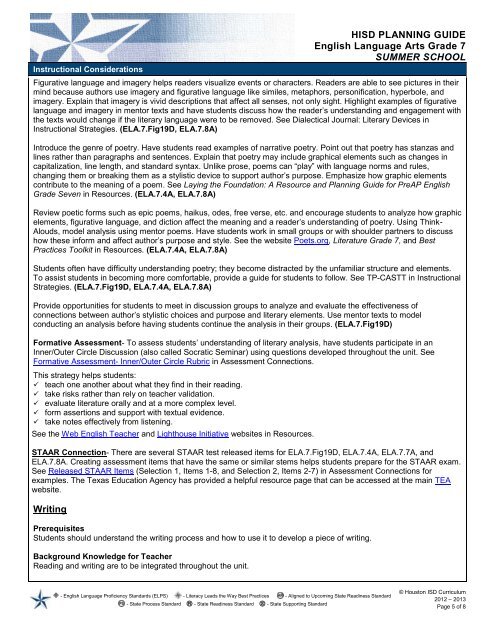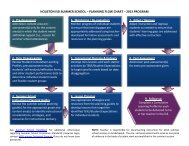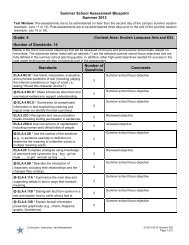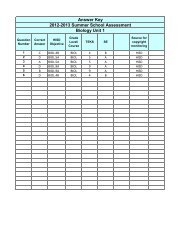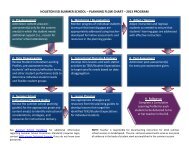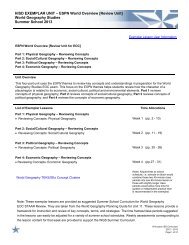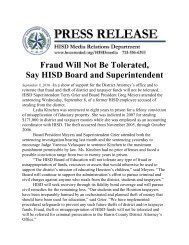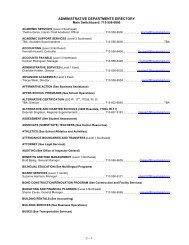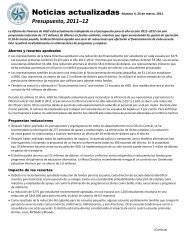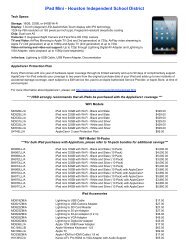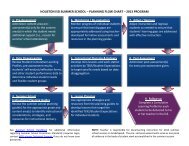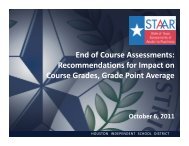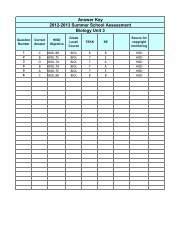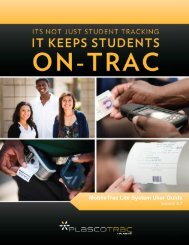SSK Unit 4.2 Planning Guide
SSK Unit 4.2 Planning Guide
SSK Unit 4.2 Planning Guide
- No tags were found...
You also want an ePaper? Increase the reach of your titles
YUMPU automatically turns print PDFs into web optimized ePapers that Google loves.
Instructional ConsiderationsHISD PLANNING GUIDEEnglish Language Arts Grade 7SUMMER SCHOOLFigurative language and imagery helps readers visualize events or characters. Readers are able to see pictures in theirmind because authors use imagery and figurative language like similes, metaphors, personification, hyperbole, andimagery. Explain that imagery is vivid descriptions that affect all senses, not only sight. Highlight examples of figurativelanguage and imagery in mentor texts and have students discuss how the reader’s understanding and engagement withthe texts would change if the literary language were to be removed. See Dialectical Journal: Literary Devices inInstructional Strategies. (ELA.7.Fig19D, ELA.7.8A)Introduce the genre of poetry. Have students read examples of narrative poetry. Point out that poetry has stanzas andlines rather than paragraphs and sentences. Explain that poetry may include graphical elements such as changes incapitalization, line length, and standard syntax. Unlike prose, poems can “play” with language norms and rules,changing them or breaking them as a stylistic device to support author’s purpose. Emphasize how graphic elementscontribute to the meaning of a poem. See Laying the Foundation: A Resource and <strong>Planning</strong> <strong>Guide</strong> for PreAP EnglishGrade Seven in Resources. (ELA.7.4A, ELA.7.8A)Review poetic forms such as epic poems, haikus, odes, free verse, etc. and encourage students to analyze how graphicelements, figurative language, and diction affect the meaning and a reader’s understanding of poetry. Using Think-Alouds, model analysis using mentor poems. Have students work in small groups or with shoulder partners to discusshow these inform and affect author’s purpose and style. See the website Poets.org, Literature Grade 7, and BestPractices Toolkit in Resources. (ELA.7.4A, ELA.7.8A)Students often have difficulty understanding poetry; they become distracted by the unfamiliar structure and elements.To assist students in becoming more comfortable, provide a guide for students to follow. See TP-CASTT in InstructionalStrategies. (ELA.7.Fig19D, ELA.7.4A, ELA.7.8A)Provide opportunities for students to meet in discussion groups to analyze and evaluate the effectiveness ofconnections between author’s stylistic choices and purpose and literary elements. Use mentor texts to modelconducting an analysis before having students continue the analysis in their groups. (ELA.7.Fig19D)Formative Assessment- To assess students’ understanding of literary analysis, have students participate in anInner/Outer Circle Discussion (also called Socratic Seminar) using questions developed throughout the unit. SeeFormative Assessment- Inner/Outer Circle Rubric in Assessment Connections.This strategy helps students: teach one another about what they find in their reading. take risks rather than rely on teacher validation. evaluate literature orally and at a more complex level. form assertions and support with textual evidence. take notes effectively from listening.See the Web English Teacher and Lighthouse Initiative websites in Resources.STAAR Connection- There are several STAAR test released items for ELA.7.Fig19D, ELA.7.4A, ELA.7.7A, andELA.7.8A. Creating assessment items that have the same or similar stems helps students prepare for the STAAR exam.See Released STAAR Items (Selection 1, Items 1-8, and Selection 2, Items 2-7) in Assessment Connections forexamples. The Texas Education Agency has provided a helpful resource page that can be accessed at the main TEAwebsite.WritingPrerequisitesStudents should understand the writing process and how to use it to develop a piece of writing.Background Knowledge for TeacherReading and writing are to be integrated throughout the unit. - English Language Proficiency Standards (ELPS) - Literacy Leads the Way Best Practices - Aligned to Upcoming State Readiness Standard- State Process Standard R - State Readiness Standard S - State Supporting Standard© Houston ISD Curriculum2012 – 2013Page 5 of 8


